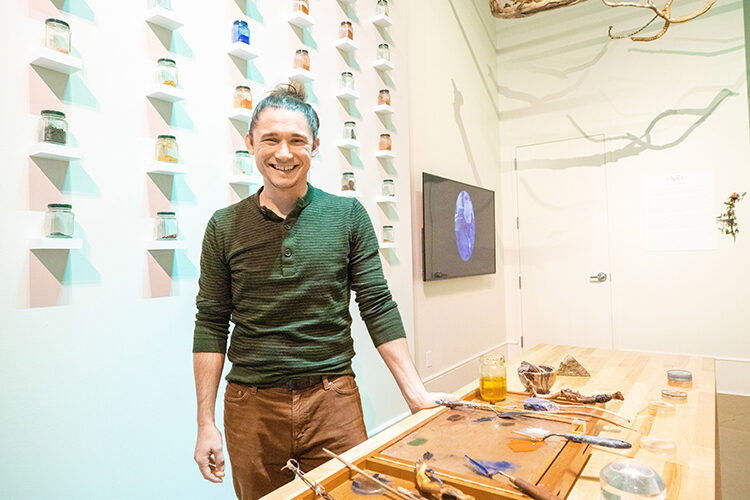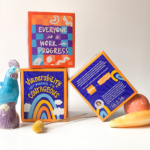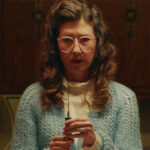Jeff Zimpel thinks of his studio as a beating heart, with the people flowing through it the lifeblood of art and the creative process.
Zimpel, who earned his MFA in art from UWM in 2021, is the first-ever artist-in-residence at Saint Kate-The Arts Hotel.
The studio’s downtown location, on the hotel’s first floor just off the entrance to the Milwaukee Center, attracts hotel guests, casual passers-by and people going to the nearby theaters and restaurants.
How visitors interact with Zimpel and the studio can range from sharing ideas about photos on display or creating and using watercolors to make their own mark or create their own work of art.
“It’s an unbelievably vibrant space,” Zimpel said. “It’s porous. People come in a rush, and at the end of the day, they go on around the city, the state, the world.”
Collaborating with the public
Zimpel started the residency in September and will continue it until August. He is also an instructional designer with Arts@Large, a nonprofit that provides access to arts experiences for students, teachers and community members.
He particularly enjoys the participatory nature of a studio that’s open to the public and invites them in for a short visit or a longer engagement with creativity.
“This is a highly collaborative space. My practice is trying to have every type of person participate.”
At the same time, he encourages visitors to not stress about taking part in the creative process. “I’m not going to press them to paint anything, but I try to give them a 360-degree platform for access.”
He may, for example, just invite visitors to share what they see in photographs displayed in the studio.
Winning over a skeptical veteran
Zimpel remembers that one of the first visitors to the studio was an older military veteran who was staying at Saint Kate’s while attending a convention. The man was a little skeptical at first, but soon found himself putting down colors and making his own marks. He still stays in touch with Zimpel by email.
Another visitor, a teenage student, was so interested in the work that her parents signed her up for a one-on-one session.
Zimpel especially enjoys having other artists – musicians, poets and visual artists – join him at the studio’s big table to collaborate on pieces. “It helps me learn, and they get to be in this vibrant space that I love so much.”
The studio also gives him the opportunity to experiment and build his own body of work, he added.
Career moved into art
Zimpel started his art career planning to be a graphic designer. He earned his BFA in that field at Cardinal Stritch University. But then, as he puts it, “I inconveniently fell in love with philosophy” and began questioning the “why” of what he was doing.
“That really disrupted my career. I always wanted to know, ‘Why are we promoting this product or designing for this publication?’”
So, he made a transition, moving to Shorewood High School to teach art for six years. That experience helped inspire him to create more of his own art.
“All my students were going off and doing such amazing projects after high school. I’d keep up with them or they’d come back and visit. At a certain point I got the itch. I had many ideas and needed time and effort to follow through.”
After many conversations with his wife about a career change, he started working full-time as an instructional designer with Arts@Large.
UWM focus on engagement
When Zimpel decided he wanted to further hone his skills, he came to UWM’s Peck School of the Arts to work on a master’s degree in fine arts and social engagement.
He chose UWM, he said, because of that focus on art in social engagement. “I was most intrigued by that. Instead of telling me what that meant, my advisors let me figure it out. That was exciting.”
He also interacted with people within and outside the art department. One of his areas of research was where art materials come from and how artistic processes developed. He found, for example, that the color ultramarine is based on lapis, a deep blue metamorphic rock that is only found in two mountain ranges in the world – one in Afghanistan and one in Chile.
That research background is reflected in his studio’s ecological approach to creative work. In fact, he calls his residency Studio Ecology.
Making their own paints
Most of the colors he offers visitors to his studio are based on minerals, clay and other materials he searched out and found in Wisconsin – making the colors predominately dark reds, browns and greens.
“Most people are used to using a set of watercolors, so this is a different experience, working with more earth tones.” If visitors want to, they can create their own paints, choosing one of the minerals and rocks on display and using a mortar and pestle to grind them into a fine powder that can then be mixed with water or even oil.
“They aren’t like store bought because the colors can shift and change.” Sometimes, visitors make the marks on resin disks that are then covered with another layer of resin, that process allows the particles to shift and change even further.
Collaborative composition
The end result of different people making marks with the colors is often collaborative composition.
“If 150 different people come through here on a Saturday and put paint to paper, the result is gorgeous,” Zimpel said. “They’re paintings I could never make myself.”
Saint Kate management is pleased with the response.
“Saint Kate is the first-of-its-kind arts hotel that serves as a creative hub for all as it fosters discussion and ignites collaboration,” said Dana Johnson, general manager. “Jeff’s practice fits in perfectly with this as he invites guests to participate in his process and see his artwork come to life firsthand. Guests who enter his studio become collaborators in his work as they help build the tools, prepare the color and exchange ideas for his next breathtaking piece, offering an experience unlike any other.”







